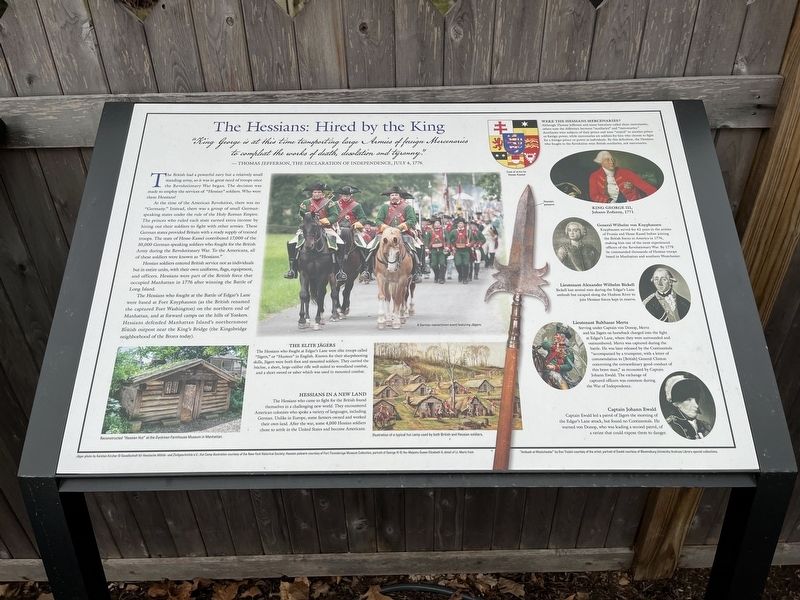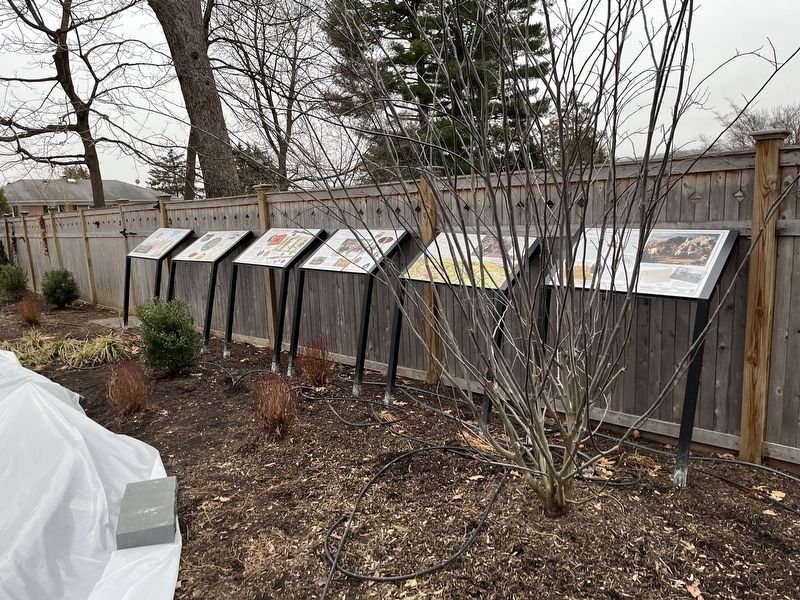Hastings-on-Hudson in Westchester County, New York — The American Northeast (Mid-Atlantic)
The Hessians: Hired by the King
"King George is at this time transporting large Armies of foreign Mercenaries to compleat the works the works of death, desolation and tyranny."
— Thomas Jefferson, The Declaration of Independence, July 4, 1776
The British had a powerful navy but a relatively small standing army, so it was in great need of troops once the Revolutionary War began. The decision was made to employ the services of "Hessian" soldiers. Who were these Hessians?
At the time of the American Revolutionary, there was no "Germany." Instead, there was a group of small German-speaking states under the rule of the Holy Roman Empire. The princes who ruled each state earned extra income by hiring out their soldiers to fight with other armies. These German states provided Britain with a ready supply of trained troops. The state of Hesse-Kassel contributed 17,0000 of the 30,000 German-speaking soldiers who fought for the British Army during the Revolutionary War. To the Americans, all of these soldiers were known as "Hessians."
Hessian soldiers entered British service not as individuals but in entire units, with their own uniforms, flags, equipment, and officers. Hessians were part of the British force that occupied Manhattan in 1776 after winning the Battle of Long Island.
The Hessians who fought at the Battle of Edgar's Lane were based at Fort Knyphausen (as the British renamed the captured Fort Washington) on the northern end of Manhattan, and at forward camps on the hills of Yonkers. Hessians defended Manhattan Island's northernmost British outpost near the King's Bridge (the Kingsbridge neighborhood of Bronx today).
The Elite Jägers
The Hessians who fought at Edgar's Lane were elite troops called "Jägers," or "Hunters" in English. Known for their sharpshooting skills, Jägers were both foot and mounted soldiers. They carried the büchse, a short, large-caliber rifle well-suited to woodland combat, and a short sword or saber which was used in mounted combat.
Hessians in a New Land
The Hessians who came to fight for the British found themselves in a challenging new world. They encountered American colonists who spoke a variety of languages, including German. Unlike in Europe, some farmers owned land and worked their own land. After the war, some 4,000 Hessian soldiers chose to settle in the United States and become Americans.
Were the Hessians Merceneries?
Although Thomas Jefferson and many historians called them mercenaries, others note the difference between "auxiliaries" and "mercenaries." Auxiliaries were subjects of their prince and were "rented" to another prince or foreign power, while
General Wilhelm von Knyphausen
Knyphausen served for 42 years in the armies of Prussia and Hesse-Kassel before joining the British forces in America in 1776, making him one of the most experienced officers of the Revolutionary War. By 1778 he commanded thousands of Hessian troops based in Manhattan and southern Westchester.
Lieutenant Alexander Wilhelm Bickell
Bickell lost several men during the Edgar's Lane ambush but escaped along the Hudson River to join Hessian forces kept in Reserve.
Lieutenant Balthasar Mertz
Serving under Captain von Donop, Mertz and his Jägers on horseback charged into the fight at Edgar's Lane, where they were surrounded and outnumbered. Mertz was captured during the battle. He was later released by the Continentals "accompanied by a trumpeter, with a letter of commendation to [British] General Clinton concerning the extraordinary good conduct of this brave man," as recounted by Captain Johann Ewald. The exchange of captured officers was common during the War of Independence.
Captain Johann Ewald
Captain Ewald led a patrol of Jägers the morning of the Edgar's Lane attack, but found no Continentals. He warned von Donop, who was leading a second patrol, of a ravine that could expose them to danger.
Topics and series. This historical marker is listed in these topic lists: Agriculture • Forts and Castles • Settlements & Settlers • War, US Revolutionary. In addition, it is included in the Former U.S. Presidents: #03 Thomas Jefferson series list. A significant historical date for this entry is July 4, 1776.
Location. 40° 59.884′ N, 73° 52.902′ W. Marker is in Hastings-on-Hudson, New York, in Westchester County. Marker is at the intersection of Warburton Avenue and Broadway (U.S. 9), on the right when traveling south on Warburton Avenue. Touch for map. Marker is at or near this postal address: 623 Warburton Ave, Hastings on Hudson NY 10706, United States of America. Touch for directions.
Other nearby markers. At least 8 other markers are within walking distance of this marker. Washington's Continental Army (here, next to this marker); The Battle of Edgar's Lane (here, next to this marker); After the Battle (here, next to this marker); Seven Years of Fear: Hastings and the Neutral Ground (here, next to this marker); The American Revolution in 1778 (here, next to this marker); The Skirmish of Edgar's Lane (a few steps from this marker); Community Gardens in Zinsser Park / Los Jardines Comunitarios en el Parque Zinsser (a few steps from this marker); a different marker also named Battle of Edgar's Lane (within shouting distance of this marker). Touch for a list and map of all markers in Hastings-on-Hudson.
Credits. This page was last revised on March 12, 2022. It was originally submitted on March 12, 2022, by Devry Becker Jones of Washington, District of Columbia. This page has been viewed 206 times since then and 16 times this year. Photos: 1, 2. submitted on March 12, 2022, by Devry Becker Jones of Washington, District of Columbia.

